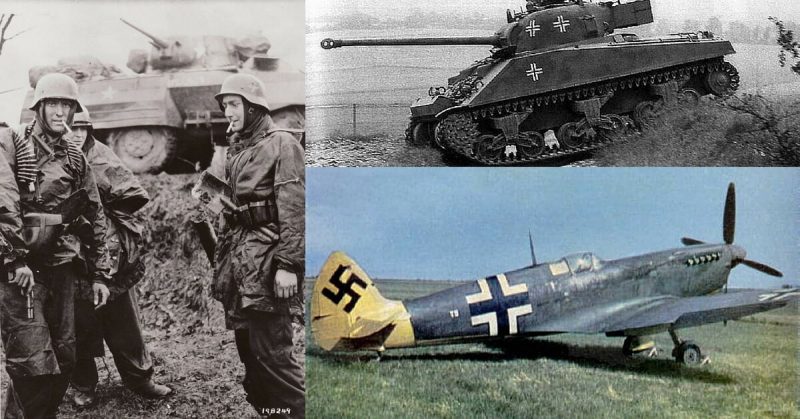The Germans during WWII were known for their engineering craftsmanship, but a less known fact is that they were very resourceful in times of need, confiscating and adjusting their enemy’s weaponry for their own goals.
Numerous photographs prove how the German war machine functioned on the tanks and vehicles seized after the occupation of Czechoslovakia, Poland, France, Belgium, Netherlands and other countries. Later, the Germans incorporated Soviet tanks, small arms, and artillery. They would rename the captured weapons and stamp them with a swastika or a German Cross.
The first years of the Nazi conquest were still plagued by the lack of motorized infantry units and tanks that proved to be technically inferior to the French ones. Nevertheless, an element of surprise, strong fighting spirits, and superior tactics kept the German war machine rolling during the first two years of the war.
As the war carried on, supplies were scarce and the salvage tactic became more common. The Germans used Allied planes, tanks, and vehicles, throwing everything they got in the defense of the Reich.
Czechoslovakia
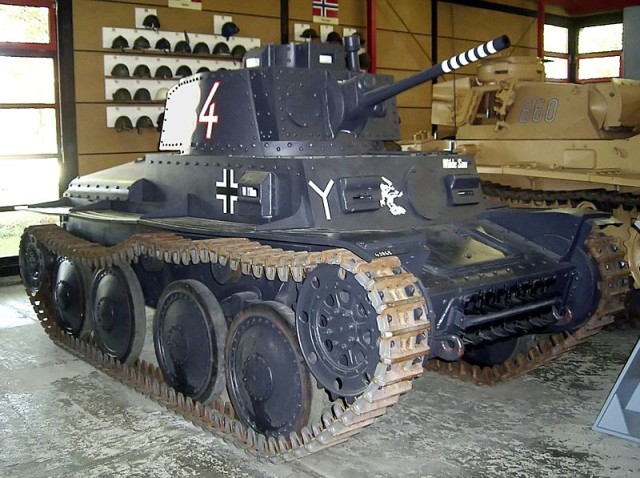
Czechoslovakia was peacefully occupied, falling a victim to the German diplomatic pressure. Since the country surrendered without a fight, its army, and complete military industry fell into the hands of the Germans. During the 1930s Czechoslovakian tanks were considered top notch. This is why the Germans decided to adopt their designs and basically rename the existing models such as the LT vz. 35 and LT vz. 38, into Panzer 35(t) and 38(t). The stands for Tschechisch, the German ford Czech.
The Germans produced 1400 of the PzKw. 38 and 434 PzKw. 35 that were mostly used during the invasions of Poland, France, and the Soviet Union. In 1942, the tanks were already considered obsolete and most of the surviving units were sent to serve in the German puppet states, such as the Independent State of Slovakia, Romania, and Bulgaria.
Poland
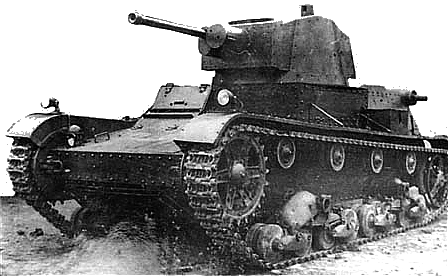
As Poland fell in the first months of the war, a vast majority of the Polish Army was captured. Along with them, the Germans captured most of their tanks. The Germans incorporated the Polish 7TP light tank, which was technically superior to the German light tanks of the time.
The tank utilized a Bofors wz. 37 anti-tank gun which could penetrate any German armor, including the one of the Panzer IV. The Panzer IV was the newest addition to the German arsenal during the Polish campaign, but it was still vulnerable to the 7TP. On the other hand, the Polish tank was too lightly armored and especially vulnerable to aerial bombardment. The tanks were mostly used on the Eastern Front, but the one on the picture was captured by the Allies in France, in 1944.
Netherlands
Netherlands was one of the many European countries that capitulated under Blitzkrieg, without getting a chance to put out a decent fight. Some of the armor formerly used in the Royal Netherlands Army was quickly incorporated into the German Army. As the Germans were still in deficit with AFVs (Armored Fighting Vehicles), they were keen in capturing as many of the Dutch DAF M36 and M39, as well as the Swedish-made Landsverk L-180s series armored vehicles that were purchased by the Netherlands Army prior to the war.
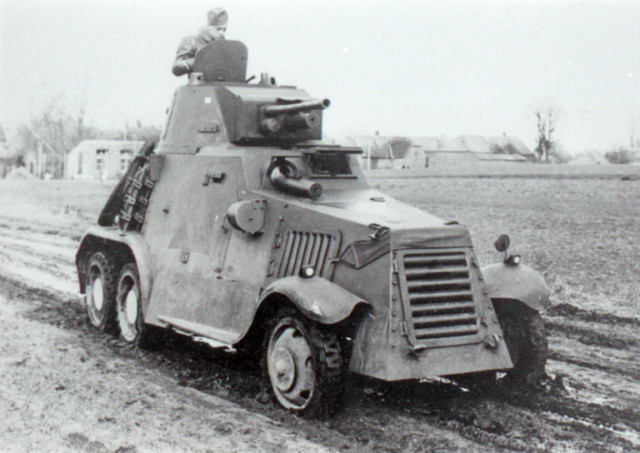
These armored vehicles were used mostly for reconnaissance and police service. Even though their numbers were small (less than ten of the each model was incorporated into active service) most of these vehicles served during the Invasion of France and Operation Barbarossa.
France
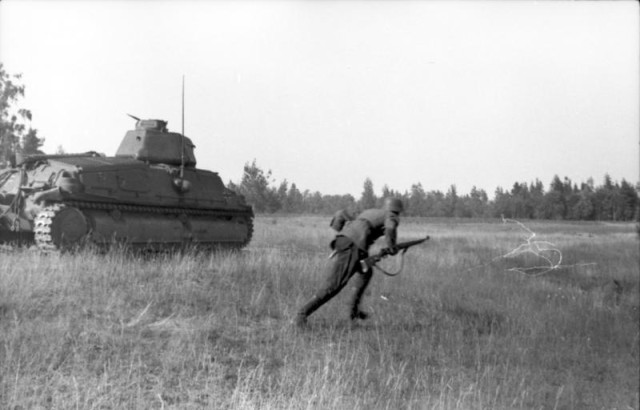
France was considered to be the main military force of continental Europe. Its tanks were seen as the cutting edge of modern engineering. This is why they were confiscated and used by the Germans, most notably during the early stages of the invasion of USSR. A variety of tanks, tank destroyers, AFVs and other transport vehicles salvaged from the French Army were successfully incorporated. The turning point of the first years of WWII was the catastrophic defeat of France.
The Lorraine tractor series ― Lorraine 37L. 15 cm sFH 13/1; 7,5 cm Pak 40/1; leFH 18/4, were successfully used on the Eastern Front. The Renault tanks such as the FT and R35 participated in the conquest of Balkan. The Hotchkiss H35 and H39 filled the ranks in the occupied territories. Among other models, the SOMUA S35, a very esteemed medium tank of the French Army, saw its combat use as 297 vehicles that were captured by the Germans were distributed to the Axis allies such as Italy, Hungary, and Bulgaria. Still, a vast majority of these tanks was adjusted to serve the German armored divisions. It saw extensive combat at the Eastern Front, especially the Siege of Sevastopol in 1942. Besides from tanks, the Germans operated with French mortars and anti-tank guns such as the Mortier de 280 modèle 1914 Schneider and the 25mm Puteaux anti-tank gun model 1937
USSR
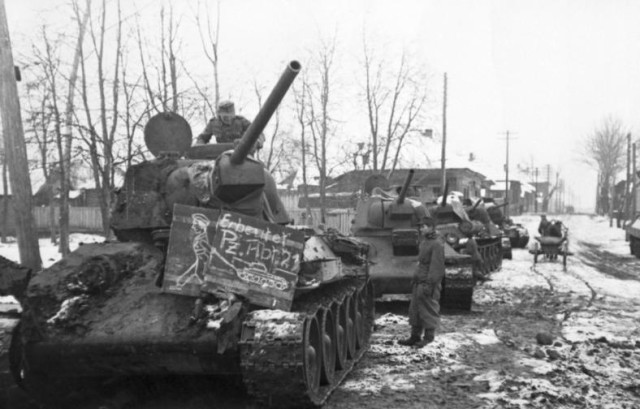
Since the use of captured vehicles became common by 1941, when Operation Barbarossa commenced, a variety of all sorts of different tanks, half-tracks, self-propelled artillery pieces and armor fighting vehicles descended on the Soviet Union. The practice to use the enemies weapons against him continued. The Germans even incorporated Soviet-made submachine guns such as the PPSh and semi-automatic rifles. The Germans mostly confiscated the iconic T-34 medium tanks, but they also relied on the KV-1 and KV-2 heavy tanks which were known for their sturdy armor and devastating firepower.
Other tanks, armored cars, and half-tracks were recorded to be used by the Germans during the Eastern offensives. Tanks such as BT-7, T-28, T-37, T-40 etc., joined with armored cars from the BA (Broneavtomobil) series, like the BA-20, BA-3/6, BA-10. In May 1945, two of the IS-2 heavy tanks were captured and reused by the Germans.
Great Britain
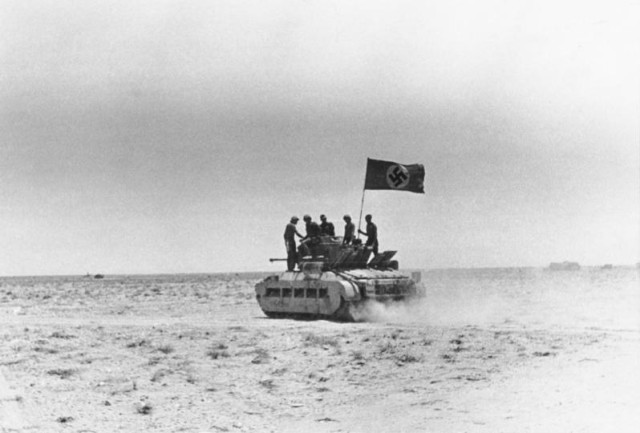
After the devastating retreat at Dunkirk, the British Expeditionary Force left behind them 2,472 guns, 20,000 motorcycles, and almost 65,000 other vehicles; also abandoned were 416,000 short tons (377,000 t) of stores, more than 75,000 short tons (68,000 t) of ammunition and 162,000 short tons (147,000 t) of fuel. Almost all of the 445 tanks stationed in France with the BEF had to be abandoned.
On this occasion the Germans reissued the Matilda tank, renaming it Infanterie Panzerkampfwagen Mk.II 748(e), (e) for English. German tank crews considered the tank very effective, but the use in battle often caused confusion on both sides. Besides from the Matilda tanks, the Germans used the Humber armored cars and Bren Gun Carriers. Also, the Germans really fancied the AEC Dorchester Armoured Buses, which were used as field command vehicles. Two of them, named “Max” and “Moritz”, were employed by Rommel and his staff throughout the North African campaign. Also, a number of Spitfires was used by the Luftwaffe. The KG 200 Luftwaffe unit, which specialized in long-distance reconnaissance, difficult bombing operations, and prototype testing, incorporated most of the captured Allied planes, including the American B-17 bombers. By the end of the war, pilots who operated the captured planes were often involved in “false flag” operations, with the intention to confuse the Allies. They were also involved in a number of suicide missions.
USA
When the US troops, together with other Allied soldiers, landed in France, in 1944, the force of the German Army was already heavily in decline. The Germans pressed into service almost any vehicle that they managed to capture. American tanks, support vehicles, and bombers could all be seen stamped with Nazi insignia. Like in the Eastern Front, some firearms were also adopted and used by German soldiers.
As the war was slowly coming to its end, the Germans were becoming more and more resourceful. They were often staging false flag operations, of which the most famous one is Operation Grief, conducted by the notorious Otto Skorzeny. On this occasion, a number of Stuarts, Shermans, Fireflies and Greyhound Light Armored Vehicles captured in earlier battles were part of the operation that intended to disrupt the communications among the Allies, cause confusion, panic, fear and mistrust between American troops. For this occasion, captured Allied uniforms and small arms were also used.
Besides from the use in false flag operations, American tanks, like many other, were marked with German insignia and sent to the frontlines in France, Belgium, Netherlands and eventually Germany.
As it was mentioned before, a few B-17 bombers were flying under Luftwaffe markings. In addition to the bombers, a number of P-51 Mustang fighter-bombers also saw combat on the enemy side.
